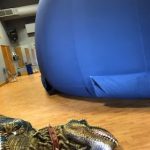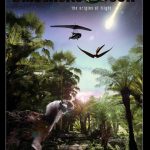Dinosaur Dome
Experience the immersive power of our full domes and interactive teaching.
Learn with us all about dinosaurs in a fun and illustrative way.
Dinosaur Dome UK
Dinosaur Dome is designed to explore science, geology and geography in an interactive way. The Dome visits schools, clubs, events and festivals, providing an additional science resource and presenting a different learning experience to children.
We provide educative, immersive digital mobile planetarium sessions; showing different environments and natural history shows (‘rocks, soils & fossils’; under the sea and dinosaurs) to schools, colleges, youth clubs, scout groups and playgroups. The service is provided in a blacked-out purpose built mobile domes to be sited indoors in a school hall or gymnasium. Our domes are the most advanced digital domes in the country, capable of showing 360 degree pictures and feature films.
With over 15 years of experience working for numerous schools, big festivals and local events. We can cater to your needs for indoor set ups and small or large outdoor events. We cover the whole of the UK and are the biggest portable pop-up planetarium and science dome business in the country.
Dinosaur Dome Programme
Dinosaur Dome offers shows for all age groups. From dinosaurs, “rocks, soils & fossils” to plate tectonics & continental drift for older pupils. We can provide shows that fit in to your teaching activities in science, geology and geography; giving students an exciting, interactive and enjoyable experience that they will never forget!
With us your students will be able to examine and touch real fossils, rocks, dinosaur bones and ancient oceanic fossils. They will see the interconnection between sciences such as geology, astronomy, and physics as well as be challenged and encouraged to explore science themselves.
Check out our exciting Dinosaur Dome Programme below and if you require a specific topic that’s not on the list, just get in touch as we will very likely be able to help.
KS1/2/3 on Dinosaur Show
The show includes immersive full dome 360 degree images of dinosaurs. Our giant 360 degree projector is used to walk through a dinosaur landscape.
The show starts with time travel back to the Jurassic times and pictures of early earth landscapes. The programme then gives an interactive introduction to dinosaurs and talks about the fossils in the local Jurassic coast. 360 degree pictures of dinosaurs are used in the show. Real dinosaur fossils for the children to hold and examine are included.
The show ends with possible ways of dinosaur extinction such as a large meteorite. We then look at the stars using the planetarium. We observe many shooting stars and the night’s sky.
An extensive Rocks and Fossils collection is available to examine and some sample can be purchase by the children, if desired. Makes a great day suitable for reception onwards and can include KS1/KS2 materials with rocks and soils.
KS2/3/4 on Rocks, Soils & Fossils
KS1/2/3/4 on Down to Earth (Fossils and Earth's History).
KS1/2/3 on Dinosaurs at Dusk
Experience the thrill of paragliding over the countryside; feel what it’s like to soar like a falcon; and travel back in time to meet the flying pterosaurs, and the ancestors of modern day birds.
Dinosaurs at Dusk is all about flying and dinosaurs. A one-of-a-kind learning adventure in the most amazing movie format ever invented!
Science content also includes topics such as continental drift, proper motion of stars, asteroids and impacts, extinctions and the convergent development of flight among species.
KS2/3/4 on 'Dinosaurs and past life'.
The show includes dinosaur pictures in 3D using 3D glasses (provided) and also real dinosaur fossils to hold and examine. Our giant 180 degree projector is used to walk through a dinosaur landscape.
The show starts with time travel back to the Jurassic times and pictures of early earth landscapes. The programme then gives an interactive introduction to dinosaurs and talks about the fossils in the local Jurassic coast.
The show ends with possible ways of dinosaur extinction such as a large meteorite. We then look at the stars using the planetarium. We observe many shooting stars and the night’s sky.
An extensive Rocks and Fossils collection is available to examine and some sample can be purchase by the children, if desired. Makes a great day suitable for reception onwards and can include KS1/KS2 materials with rocks and soils.
Explore our Dinosaur Dome Sessions
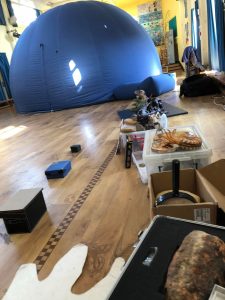
Rates
Full day visit costs £580 (excluding VAT) with a typical day including up to five class shows.
Half day costs for three shows is £480.
Local BCP Council price discount: £530 (full day) and £430 (half day).
We may charge extra for a sixth show during the day. If your school is located near one of our dome bases (Bournemouth, Wimborne (Dorset), Brighton, Trowbridge, London, Leeds, and Newark (Nottinghamshire)), then we may be able to come for a half day. Please apply for half day rates if the case.
Please be aware that we charge a travel and hotel supplement if we are required to travel a distance from a base.
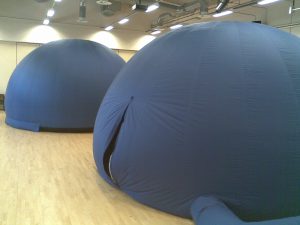
Bookings
Contact us for further information and bookings on 01202 304734, send us an email to info@sciencedome.co.uk, or alternatively click the bottom down below and fill in the form. We will get in touch with you soon after we receive your request.
Popular Questions
Got a question? We are here to help.
How far can you travel?
What's the dome size?
The Science Dome operates eleven mobile digital domes. The dimensions of these domes go from 5-8 meters diameter and 3-5 meters height. Being able to provide different sizes and designs to fit all school and village halls.
For the “wow” factor of a large immersive display environment to entertain large numbers of viewers at a show (or other such venue) our immersive 8m diameter domes would be the ideal match. Being 5.2 metres high, this dome offers a large feature in any show.
How many people can fit in the dome?
Our domes provide different sizes and designs to cater to your needs. Their capacity rank from 25-50 adults till 35-60 primary children in a session.
Get in touch, we will give you a precise feedback according to the type of audience or students’ age to help with the organisation.
Can we have more than one topic on the day?
Of course you can.
Get in touch and we will help you organise the sessions.
Check out our other domes: Dinosaur Dome and Fractals Dome to explore deeper all the different topics we can cover.
How much does it cost to hire your service?
For Schools Service:
Full day visit costs £530 (excluding VAT) with a typical day including up to five class shows.
Half day costs for three shows is £430.
We may charge extra for a sixth show during the day. If your school is located near one of our dome bases (see below), then we may be able to come for a half day. Please apply for half day rates if the case.
Please be aware that we charge a travel and hotel supplement if we are required to travel a distance from a base.
For Youth Clubs, Scout Groups and Adults Groups:
Prices start from £175 per session (an hour). Please contact us and will give you a totally free quote according to the type of service you require.
For Outdoor Events:
The cost for a smaller 25 person size dome (30 with children) is £750 per day, plus VAT and travel costs.
The cost for the giant dome version 40 person dome (45 with children) is £950 per day, plus VAT and travel costs.
Please be aware that the cost reflects a two-man operation.
Both domes come with limited soft benches (seating 10 to 15), with cushions for the remaining space.
If cost is a problem and you are a school fair organiser, for schools fairs we may be able to earn an income for the school by a modest audience charge, with our spilt fees facility. No charge (as above) for booking but we charge the public on entrance and spilt the fees. Only available for schools to support in south of England, Hants and Dorset, travel and hire cost apply to rest of UK.
Fun Facts About Dinosaurs
Dinosaur fossils have been found on all seven continents.
There are about 700 known species of extinct dinosaurs.
The UK ranks the seventh position in the world in regards to dinosaur fossils findings with over 500 noteworthy finds.
Meat eaters VS plant eaters. How nature helped these second ones on the fight?
Modern birds are a kind of dinosaur because they share a common ancestor with non-avian dinosaurs.
How many teeth did Triceratops have?
How long could T. Rex live?
It is believed that dinosaurs lived on Earth until around 65 million years ago when a mass extinction occurred.
Please, Tell Me a Dinosaur Joke!
What do you call a dinosaur with an extensive vocabulary?
What would be the best thing to do if you see a Tyrannosaurus Rex?
What's the nickname for someone who put their right hand in the mouth of a T-Rex?
Do you know how long dinosaurs lived?
What do you get when a dinosaur sneezes?
What sport is a brontosaurus good at?
What do you call twin dinosaurs?
What do you call a smelly dinosaur fart?
What do you call a dinosaur that never gives up?
What is the best way to talk to a velociraptor?
How do you know if there is a dinosaur in your fridge?
Let's Get Curious About Dinosaurs
What is the Pangaea?
About 200 million years ago, all the continents on Earth were actually one huge “supercontinent” surrounded by one enormous ocean. This gigantic continent, called Pangaea, slowly broke apart and spread out to form the continents we know today.
When and how did dinosaurs appear?
Around 251 million years ago, at the end of the Permian period, a mass extinction wiped out most of life on Earth. In its wake arose a group of egg-laying reptile precursors called archosaurs, the common ancestors of dinosaurs, flying reptiles known as pterosaurs, and crocodiles. At some point during the next period, the Triassic, pterosaurs and dinosaurs split off from the crocodile lineage. What early dinosaurs and their closest relatives looked like still remains somehow a mystery, because few fossils exist from the dawn of the dinosaurs. However, as today, the archosaurus seems to be the closest we can get to the appearance of dinosaurs on Earth.
Since the fossil record for dinosaurs is incomplete, we do not have fossils from the very first dinosaur that ever lived. Based on the age of the specimens that we do have, that first dinosaur may well have lived in the early Triassic Period. The earliest dinosaurs for which we do have well-documented fossils are found in Late Triassic Ischigualasto Formation in northern Argentina. Skeletons discovered in these rock layers include the meat-eating dinosaurs Herrerasaurus and Eoraptor, as well as the plant-eating dinosaur Pisanosaurus.
Reference: American Museum of National History
Types of dinosaurs:
Historically, dinosaurs have been divided into two main groups: saurischians (“lizard-hipped”) and ornithischians (“bird-hipped”), classified by their hip structure. In saurischians, the two lower bones of the hip point away from each other, as in lizards; and in ornithischians, the two lower hip bones both point backwards, as in birds. Ironically, birds by ancestry are saurischians rather than ornithischians (their evolution of true “bird hips” occurred after the saurischian–ornithischian split). The saurischians are divided into theropods and sauropodomorphs. Theropods are the classic bipedal carnivorous dinosaurs, from Coelophysis to Tyrannosaurus, and also include birds. Sauropodomorphs include the enormous quadrupedal, herbivorous long-necked, long-tailed sauropods (Brachiosaurus, Diplodocus) and their cousins the “prosauropods”. Finally, the ornithischians are harder to define because they include several very different groups, but all ornithischians share a special “beak bone” (the predentary) at the tip of the lower jaw.
More about this topic at https://www.nps.gov/subjects/fossils/major-groups-of-dinosaurs
How did dinosaurs become extinct?
Today, paleontologists have discerned that most dinosaur lineages disappeared by about 66 million years ago after intense volcanic activity, climate change and a catastrophic asteroid impact triggered one of the worst mass extinctions in our planet’s history.
The Natural History Museum has a very good article about this phenomena.
How were dinosaur fossils formed?
Most living things decompose relatively quickly after death. However, if soon after they die, the remains get covered in sediment such as mud, sand, and even lava or volcanic ash. Over time layers of sediment build over the top and hardens into rock. At the same time this happens, water seeps into the sediments and bones. It leaves behind minerals, turning the bones to stones and creating a fossil. Around 99% of the fossils we find are from marine animals, such as shellfish and sharks. As they lived in the sea, mud or sand could bury them very quickly after their death. Most dinosaur fossils we have found belong to animals that were living near to a lake or a river which facilitated the remains to get covered in mud and silt. There are other events that can help fossils form, like animals that get buried when still alive by mud (rare cases) or volcanoes’ eruptions. Dinosaur can also leave behind footprints, and impressions of skin and feathers. We learn about dinosaurs through fossils, these discoveries are very important to understand the history behind us.
More on this at National History Museum
Explore Our Dome Themes
We Transform Learning Science Into Immersive Journeys
Our different dome themes provide a wide range of topics and subjects for our customers to choose among. Contact us for a chat and advice, we will guide you through the best options according to your type of event. Otherwise, please feel free to explore our domes and if you see anything in particular that you would like to have for your event, just let us know.
Hundreds of customers all around the UK enjoy our services


Interested in our services?
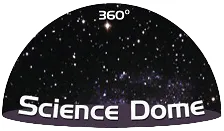
Menu
Get In Touch
020 35766463
Stay Connected
Subscribe to our newsletter and find out more:
Copyright © All Rights Reserved.

